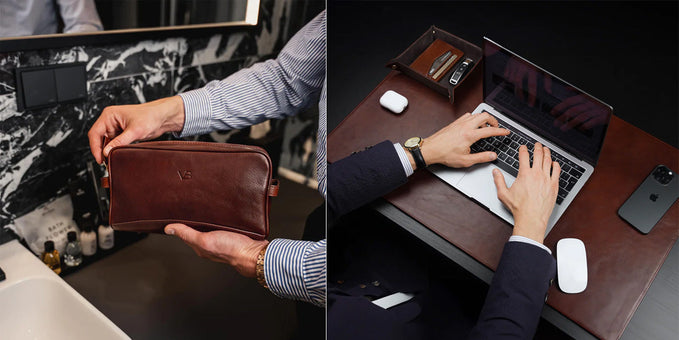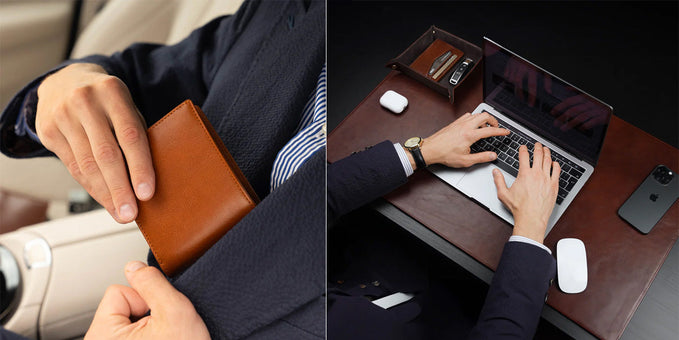Top Grain Leather

Top-grain leather is associated with high-quality products, but is in fact a slightly inferior type of leather than "full-grain leather".
It has some of the layers removed, which does help to ensure the appearance is very consistent, but loses some of the benefits of the whole hide.
In this post, we take a closer look at the product type it is used in and how this kind of leather is cared for.
What is top-grain leather?
Top-grain leather uses the outermost hide layer which is then sanded off to remove imperfections or irregularities.
It is durable, not quite as much as full-grain leather, but is still a favorable comparison to other types of leather.
How is it made?
Top grain leather is named after the sanding, shaving, and buffing process used to give it a smooth polished finish. It is very similar to full-grain leather, the difference being a couple of millimeters sanded down to get rid of some of the natural blemishes and imperfections that freshly sourced hides have.
Typically, the leather creation process has three stages. A cleaned and treated full hide is separated into layers that will create different types, strengths, and qualities of leather.
It is then re-treated and tanned to create durability and moisturized and glazed if required by the type of leather. High-quality leather goods are then made for us to purchase and use for many years.
Quality
Top grain leather is missing the hide’s outside layer, which is the part that contains the toughest fibers, and so reduces its durability when compared to full grain leather.
However, the outside layer often results in inherent defects and discolorations, and so by removing this, you get a consistency in the pattern and color of the leather.
A disadvantage of the process of manufacture is the reduction in the breathability of the leather and the hindrance of body oil and impurity absorption.
Therefore, the beautiful patina that makes full-grain leather very desirable cannot be developed. That's why at Von Baer, we only use full-grain leather in all of our bags.
Appearance
Once the hide’s top layer is sanded off, an imitation grain is imprinted onto it which results in a uniform consistency. It can be stamped with snakeskin, alligator or ostrich patterns, etc.
As this type of leather is easier to work with, it works for a wide range of products that need flexibility with a uniform appearance. It doesn’t have the same look and feel as the original hide but can be made to look like any desired animal.
Common Top-Grain Leather Products
A wide variety of products can be made using top-grain leather including handbags, purses, satchels, key chains, briefcases, and wallets. Exposure to the elements and rough use should be avoided as it is not as tough as full-grain leather.
Related:
- Leather
- Faux leather
- Vegan leather
- Faux leather vs real leather
- Bonded leather
- Genuine leather
- Pleather
- Leather types
- Leather guide for beginners
- What is leather patina
- Vegetable tanned leather
- Leather tanning
- What is artificial leather?
- What is full grain leather
Advantages
This leather has the main advantage of being easier to work with providing a consistent finish. Although full-grain leather is more durable, it will still last longer than lower-grade leather, is less costly, and can mimic other exotic leathers by patterning and dyeing.
Disadvantages
A decrease in breathability and durability is caused by sanding and buffing to remove defects and scars in the hide. Also, it is unable to absorb body oils which prevent patina development. Brittleness and cracking are more likely without proper care and their life can be shortened. The personality and individuality of full-grain leather are not present to preserve the story of the animal it came from.
How to Care for Top-Grain Leather
Life can be prolonged with proper maintenance. Always store in a dry, cool place. If it comes into contact with liquid or moisture, wipe it with a clean, soft cloth. Never use heat to dry as this may cause over-drying and cracking. Apply leather conditioner twice a year at least. Dirty leather may need high-quality leather soap.
Storage in a plastic cover should be avoided as this can sometimes result in mold. To remove mold, a clean and soft cloth that’s dipped in a solution of isopropyl alcohol and an equal proportion of water should be used.
Related articles:
- Where does leather come from
- Mushroom leather
- Napa leather
- Pebbled leather
- Leather grades
- How is leather made
- Italian leather
- How to tell if leather is real
- Buffalo leather
- Suede vs Leather
- What is Real Leather
- Pu Leather vs Faux Leather
- Alternative Leather
- Chrome Tan Leather
Top Grain Leather vs. Full Grain Leather
Full-grain and top-grain leathers are similar as they are both made by tanning animal hides.
However, with full grain, the top layer is not removed but is usually treated with aniline dyes to display the look of the original animal’s skin including blemishes and scars.
Full grain is a higher price, more beautiful, and of a higher-quality than top-grain, therefore, it’s found in smaller quantities and on more luxurious products.
The two options are both suited to luxury goods, but a full-grain leather patina means it will age more gracefully. That's why at Vonbaer.com, we only make bags from full-grain leather.
Top-grain leather can sometimes be shinier than full-grain due to raw material tanning and treatment. However, this is not always the case. Many discover the slightly smoother finish is easier to care for.
Both make excellent materials for the production of high-quality products. The tight-knit fibers give strength and stability which means they can last for decades with the proper care.
Top-grain leather has undergone a process to remove or hide any imperfections and is very commonly used as high-quality leather due to its more polished finish.
This is its main difference. Many luxury items such as duffle bags, backpacks, and travel bags are available that still maintain leather qualities that are classical and also very stylish.
Related:
- Repair cat scratches on leather
- Remove water stains from leather
- Clean leather wallet & remove stains/smells
- Remove ink from leather
- Get smell out of leather
- Remove stains from leather shoes
- Clean suede leather bag
- How to reform a leather bag
- How to maintain leather bags
- Repair cracked leather
- Wet leather
- How to clean leather bag
- How to restore faded leather bag
- Suede
- PU leather
- Bonded leather vs Faux leather
Conclusion
We hope you enjoyed our article on top-grain leather.
If you have any questions, leave them in the comments or email Von Baer at info@vonbaer.com.
Browse related leather pages here.

Author: Albert Varkki
Albert Varkki is the co-founder of Von Baer. He understands leather products as a consumer, supplier, and a manufacturer, helping you with the inside knowledge you need, to choose the perfect leather product for you.
We strive for the highest editorial standards, and to only publish accurate information on our website.
Leave a Comment
Your email address will not be published.






